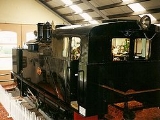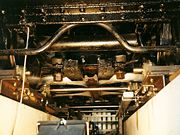
NZR H class
Encyclopedia

New Zealand Railways Department
The New Zealand Railways Department, NZR or NZGR and often known as the "Railways", was a government department charged with owning and maintaining New Zealand's railway infrastructure and operating the railway system. The Department was created in 1880 and was reformed in 1981 into the New...
H class locomotive was a unique class of locomotive used by the New Zealand Railways Department
New Zealand Railways Department
The New Zealand Railways Department, NZR or NZGR and often known as the "Railways", was a government department charged with owning and maintaining New Zealand's railway infrastructure and operating the railway system. The Department was created in 1880 and was reformed in 1981 into the New...
on the famous Rimutaka Incline, the three-mile section of 1 in 15 gradient between Cross Creek and Summit, over the Rimutaka Ranges. The locomotives worked on the Fell mountain railway system
Fell mountain railway system
The Fell system uses a raised centre rail between the two running rails on steeply-graded railway lines to provide extra traction and braking, or braking alone. Trains are propelled by wheels or braked by shoes pressed horizontally onto the centre rail, as well as by means of the normal running...
and had four horizontal driving wheels between the frames, gripping a centre rail and providing the extra adhesion needed for the climb. The outside engines drove the rear pair of coupled wheels of 32" diameter, and the inside cylinders four spring-loaded grip wheels of 22" diameter. On the descent, powerful hand-brakes bore against the centre rail, and brake vans with similar braking gear were interspersed at intervals in the train. The locomotives were never required to run at speeds higher than 15 mph, and their usual operating speed was between four and six mph ascending the incline, about ten mph descending.
Withdrawal
After the Second World War, the locomotives were starting to show their age, and the New Zealand government was looking for a way to cut time between Wellington and the Wairarapa. On 7 May 1951, the contract to construct the 8.8 kilometres (5.5 mi) Rimutaka TunnelRimutaka Tunnel
The Rimutaka Tunnel is a railway tunnel through New Zealand's Rimutaka Ranges, between Maymorn, near Upper Hutt, and Featherston, on the Wairarapa Line.The tunnel, which was opened to traffic on 3 November 1955, is long...
was let, which spelled the imminent end of the incline, and the need for the H class.
The last revenue service for the H class was on 29 October 1955, when locomotives 199, 201, 202, 203 and 204 hauled a Carterton Show day excursion train up the incline on the return journey to Wellington. When the Rimutaka Tunnel opened five days later, the engines were put to work dismantling the incline that they had travelled on for 77 years.
All the locomotives were officially withdrawn in March 1956, and all except H 199 were then towed to Silverstream
Silverstream
Silverstream is a suburb of Upper Hutt in the lower North Island of New Zealand. It is at the southern end of the city close to the Taita Gorge, which separates Upper Hutt from Lower Hutt...
in Upper Hutt and broken up for scrap.
Preservation
At the opening ceremony for the Rimutaka Tunnel on 3 November 1955, the then Minister of RailwaysMinister of Railways (New Zealand)
The Minister of Railways was the minister in the government responsible for the New Zealand Railways Department 1895–1981, the New Zealand Railways Corporation 1981–1993, and New Zealand Rail Limited 1990–1993...
John McAlpine
John McAlpine
Sir John Kenneth McAlpine, KCMG was a New Zealand politician of the National Party. He was the Member of Parliament for Selwyn from 1946 to 1966, when he retired....
gifted locomotive H 199 to the town of Featherston
Featherston, New Zealand
Featherston is a town in the north of the Wellington Region region of New Zealand. It lies in the Wairarapa, just north of the Rimutaka Tunnel, in the South Wairarapa District. The population was 2,340 in the 2006 Census....
. Following dismantling the incline, H 199 was stored at Woburn
Woburn, New Zealand
Woburn is a suburb of Lower Hutt, Wellington situated at the bottom of the North Island of New Zealand.Henry Petre farmed the area in the 1840s and named the area after the Duke of Bedford's estate, Woburn Abbey. Petre's farm was later taken over by Daniel and Harriet Riddiford, whose descendants...
for three years, before being moved through the Rimutaka Tunnel to Featherston. The locomotive was placed on a concrete plinth in a children's playground.
Over the years, exposure to the elements and vandalism had deteriorated the locomotive's condition. In 1980, the Friends of the Fell Society was formed with the intention of restoring H 199 for static display. Restoration began in 1981, and in 1984, the locomotive was moved into the new Fell Engine Museum
Fell Engine Museum
The Fell Engine Museum in Featherston, New Zealand, is a museum based around the only remaining Fell railway locomotive in the world.This locomotive, number H 199, climbed up the Rimutaka Incline using John Barraclough Fell's unique method of four grip wheels on a raised center rail.H 199 is one...
adjacent to the playground. The restoration of the locomotive was completed in 1989.
Class register
| Number | Builder | Introduced | Withdrawn | Notes |
|---|---|---|---|---|
| 199 | Avonside | Originally H 1 and named Mont Cenis Mont Cenis Mont Cenis is a massif and pass in Savoie in France which forms the limit between the Cottian and Graian Alps.A road over the pass was built between 1803 and 1810 by Napoleon... Preserved on static display at Fell Engine Museum Fell Engine Museum The Fell Engine Museum in Featherston, New Zealand, is a museum based around the only remaining Fell railway locomotive in the world.This locomotive, number H 199, climbed up the Rimutaka Incline using John Barraclough Fell's unique method of four grip wheels on a raised center rail.H 199 is one... , Featherston Featherston, New Zealand Featherston is a town in the north of the Wellington Region region of New Zealand. It lies in the Wairarapa, just north of the Rimutaka Tunnel, in the South Wairarapa District. The population was 2,340 in the 2006 Census.... |
||
| 200 | Avonside | Originally H 2 and named Mount Cook Aoraki/Mount Cook Aoraki / Mount Cook is the highest mountain in New Zealand, reaching .It lies in the Southern Alps, the mountain range which runs the length of the South Island. A popular tourist destination, it is also a favourite challenge for mountain climbers... Scrapped at Silverstream Silverstream Silverstream is a suburb of Upper Hutt in the lower North Island of New Zealand. It is at the southern end of the city close to the Taita Gorge, which separates Upper Hutt from Lower Hutt... in 1956 |
||
| 201 | Avonside | Originally H 3 and named Mount Egmont Scrapped at Silverstream in 1956 |
||
| 202 | Avonside | Originally H 4 and named Mount Tongariro Mount Tongariro Mount Tongariro is a volcanic complex in the North Island of New Zealand. It is located 20 kilometres to the southwest of Lake Taupo, and is the northernmost of the three active volcanoes that dominate the landscape of the central North Island.... Scrapped at Silverstream in 1956 |
||
| 203 | Neilson | Scrapped at Silverstream in 1956 | ||
| 204 | Neilson | Scrapped at Silverstream in 1956 |

